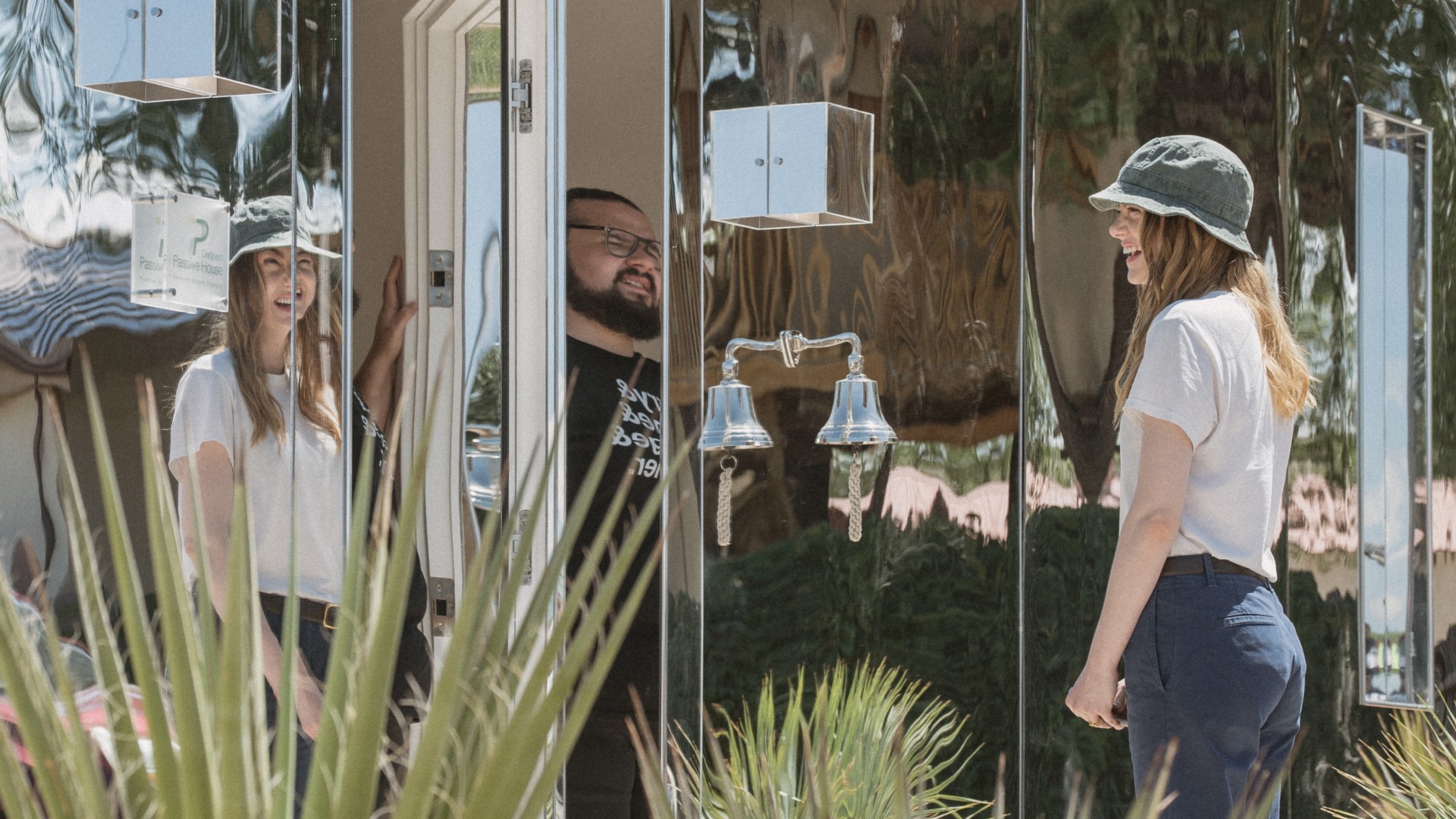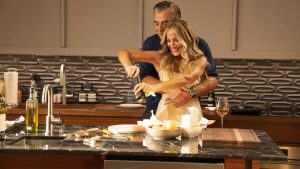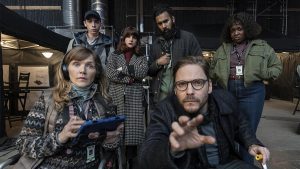
This article contains spoilers for The Curse through episode 5.
The morning after I moved into my house, I heard a thud on the back patio. And then another. And another. Three little birds were on my doorstep, but definitely not in a chilled-out Bob Marley way. They were dead. And it felt like an auspicious beginning to my family’s life in our new space.
Immediately, my mind went to The Curse, the Showtime series that follows newlyweds Asher (Nathan Fielder) and Whitney Siegel (Emma Stone), two self-styled do-good house flippers on a mission to turn old houses into passive homes. The homes are constructed to be completely energy efficient, with minimal heating or cooling systems, relying mostly on sturdy construction and extra insulation to create a thermos-like climate on the inside. The outside of the homes are Kusama-like mirrors, a design choice that might look interesting but, as a representative from a passive housing consortium emphasizes, completely unnecessary for the energy-efficient certification of the home. The mirrors also attract birds.
In the second episode of The Curse, Whitney is waiting for the completion of a blow test (we’ll get to that) when a small bird slams into the side of one of her mirrored masterpieces and dies. She sighs, acknowledging that this has happened before, and starts to brainstorm alternative options to set her architectural apparitions apart.
While my house isn’t covered in mirrors, I did get an eerie feeling of déjà vu as I watched the first few episodes of The Curse. The Curse is a show so layered with squirm-inducing interpersonal and marital strife, the borderline mortifying desire to be seen, awkward interactions, white guilt, and more that it’s hard to not see oneself in at least part of the story as it unfolds. But as someone who just finished building a near net-zero home, the story almost feels suffocating to me, much like living in a thermos.
The house that my partner and I built is not a passive house, but it does share many of the same features as Whitney’s Española creations. I don’t have a prison sink/toilet combo, but I do have an ERV, electric appliances, and insanely thick, extra insulated walls. Unlike Whitney and her quest for a Joanna Gaines-like dominance over the Española community, we weren’t focused on optics when we designed our home. Instead, we just wanted to do what we could to minimize our ecological footprint while we had the chance. Our home isn’t eligible for any fancy awards or certifications — see: gas fireplace, also: generator — and we never cared about that. We just made decisions that were right for us … and that helped us take advantage of all the tax rebates.
Pictures: Insulated Zip walls (the green boards)
Whitney, in all her controlling glory, seems to be building houses that are more of an exercise in focusing her ideologies on others instead of creating energy-efficient homes that are welcoming and comfortable to potential buyers. They are extreme in every sense of the word. The first potential buyers in episode 5, titled “It’s A Good Day,” seem to recognize that when they ask about installing an AC unit to help cope with the sweltering heat. The house I live in has something called a heat pump, an appliance which runs entirely on electricity and magic. (I’m a writer, not a scientist.) The point is, Whitney could have easily outfitted her homes with creature comforts for potential buyers and still maintained her eco-friendly goals. Building a passive, mirrored house is totally cool if that’s what you personally love, but building ten of them and then throwing a tantrum when eager buyers don’t appear is something else entirely.
In a previous episode, Whitney is incensed when Vic, the buyer from the pilot episode of Flipanthrophy, tells her that he’s ditched his fancy induction range in exchange for a gas range. This is wild on many levels — that guy is gonna need some sort of venting system to deal with the potentially noxious fumes that don’t dissipate in the thermos-like atmosphere of his new home — but Whitney is apoplectic. The gas stove means that the unit doesn’t qualify as a passive house anymore, and her dreams are being dashed by the very people she’s ostensibly trying to help.
There is one guy who loves the house: Mark Rose, played by an energetic, charismatic, and always-welcome Dean Cain. Whitney doesn’t love the guy— he has a Blue Lives Matter flag on his truck — but Mark seems to fully understand what he’s getting into, and likes the house as an off-the-grid option. He mentions thermal bridging, which shows that he’s done his homework. Long story short, thermal bridging is an issue with materials that pass straight through the construction of a home from the outdoors to the indoors, especially materials that easily conduct heat or cold like glass or metal. One solution here is to add insulation. Another is to install double or even triple-pane windows in the home to provide a buffer to trap the air before it can infiltrate your home. Or, in the peculiar case of Whitney and Asher’s homes, to maybe not even have windows? Are there windows? I don’t remember seeing any? A home with few (or no?!) windows offers maximum privacy but minimum exposure to light. It’s starting to feel like these houses really are prisons…
Or are they thermoses? Thermos prisons? That all sounds like torture. When Whitney encounters the bird, she’s waiting for a blow test at her and Asher’s newest build. A blow test is a non-invasive test that determines how much air is escaping a house. It’s completely safe to be inside during the test, so it’s a testament to just how extra Whitney is that she’s decided to step outside while it’s being conducted. Houses that are constructed to be airtight need an additional system called an HRV (Heat Recovery Ventilator) or ERV (Energy Recovery Ventilator) to help circulate fresh air inside the house, providing ventilation without destabilizing the temperature inside the dwelling.
There’s been a lot of talk about the HRVs in Whitney’s houses, but no one seems to really be interested in what they do or why they’re necessary, illustrating how much she’s missed the mark on her design as well as her chosen location. Generally, large-scale greening projects in cities are seen as desirable and can lead to gentrification and skyrocketing tax rates, displacing the people living in the surrounding community, but with Whitney’s borderline inhospitable homes going unsold, the citizens of Española can breathe a sigh of relief as they probably won’t be saddled with this unhinged, would-be white savior for much longer.
While Whitney might not be displacing the people of Española anytime soon, she’s certainly displaced the birds. And so did I. That first morning, I looked out onto my patio in horror, contemplating the cleaning job I had ahead of me and the potential ramifications of having a house that was deadly to tiny birds. The next thing I knew, a giant crow swooped in and took care of the problem for me, scooping up one of the tiny birds and soaring away like a majestic garbage disposal. Two other crows followed suit. The circle of life was on glorious display. What could be more eco-friendly than that? Our blinds were installed a few days later, and we haven’t had a bird incident since then. The crows still lie in wait every morning, though.
New episodes of The Curse stream Fridays on Paramount+ via a Showtime subscription and air Sundays at 10 p.m. ET on Showtime.
The post The Curse: What Living in an Eco-Friendly House is Really Like appeared first on Den of Geek.






